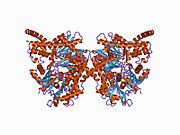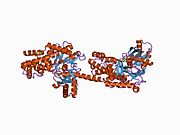HK1
Ensembl | |||||||||
|---|---|---|---|---|---|---|---|---|---|
| UniProt | |||||||||
| RefSeq (mRNA) |
| ||||||||
| RefSeq (protein) |
| ||||||||
| Location (UCSC) | Chr 10: 69.27 – 69.4 Mb | Chr 10: 62.1 – 62.22 Mb | |||||||
| PubMed search | [3] | [4] | |||||||
| View/Edit Human | View/Edit Mouse |
Hexokinase-1 (HK1) is an
Structure
HK1 is one of four highly homologous hexokinase isoforms in mammalian cells.[6][7]
Gene
The HK1 gene spans approximately 131
In addition to exon R, a stretch of the proximal promoter that contains a GATA element, an SP1 site, CCAAT, and an Ets-binding motif is necessary for expression of HK-R in erythroid cells.[6]
Protein
This gene encodes a 100 kDa
Function
As one of two mitochondrial isoforms of hexokinase and a member of the sugar kinase family, HK1
Another critical function for OMM-bound HK1 is cell survival and protection against
In the
In particular, HK1 is the most ubiquitously expressed isoform out of the four hexokinases, and constitutively expressed in most tissues, though it is majorly found in
Clinical significance
Neurodegenerative disorders
HK1 may be causally linked to
Retinitis pigmentosa
A
Interactions
HK1 is known to
Interactive pathway map
Click on genes, proteins and metabolites below to link to respective articles.[§ 1]
- ^ The interactive pathway map can be edited at WikiPathways: "GlycolysisGluconeogenesis_WP534".
See also
References
- ^ a b c GRCh38: Ensembl release 89: ENSG00000156515 – Ensembl, May 2017
- ^ a b c GRCm38: Ensembl release 89: ENSMUSG00000037012 – Ensembl, May 2017
- ^ "Human PubMed Reference:". National Center for Biotechnology Information, U.S. National Library of Medicine.
- ^ "Mouse PubMed Reference:". National Center for Biotechnology Information, U.S. National Library of Medicine.
- ^ "Entrez Gene: HK1 hexokinase 1".
- ^ S2CID 23521290.
- ^ PMID 23068103.
- ^ PMID 9493266.
- ^ PMID 10686099.
- ^ PMID 16892082.
- PMID 9540816.
- ^ PMID 9056853.
- ^ PMID 24018046.
- ^ PMID 22018957.
- ^ PMID 24560881.
- ^ S2CID 40877603.
- ^ PMID 25316723.
- PMID 21781351.
- ^ Online Mendelian Inheritance in Man (OMIM): 605285
- PMID 35872984.
- PMID 31414570.
- PMID 35422763.
- ^ PMID 25190649.
Further reading
- Daniele A, Altruda F, Ferrone M, Silengo L, Romeo G, Archidiacono N, Rocchi M (1992). "Mapping of human hexokinase 1 gene to 10q11----qter". Human Heredity. 42 (2): 107–110. PMID 1572668.
- Magnani M, Bianchi M, Casabianca A, Stocchi V, Daniele A, Altruda F, et al. (July 1992). "A recombinant human 'mini'-hexokinase is catalytically active and regulated by hexose 6-phosphates". The Biochemical Journal. 285 (Pt 1): 193–199. PMID 1637300.
- Magnani M, Serafini G, Bianchi M, Casabianca A, Stocchi V (January 1991). "Human hexokinase type I microheterogeneity is due to different amino-terminal sequences". The Journal of Biological Chemistry. 266 (1): 502–505. PMID 1985912.
- Adams V, Griffin LD, Gelb BD, McCabe ER (June 1991). "Protein kinase activity of rat brain hexokinase". Biochemical and Biophysical Research Communications. 177 (3): 1101–1106. PMID 2059200.
- Murakami K, Blei F, Tilton W, Seaman C, Piomelli S (February 1990). "An isozyme of hexokinase specific for the human red blood cell (HKR)". Blood. 75 (3): 770–775. PMID 2297576.
- Nishi S, Seino S, Bell GI (December 1988). "Human hexokinase: sequences of amino- and carboxyl-terminal halves are homologous". Biochemical and Biophysical Research Communications. 157 (3): 937–943. PMID 3207429.
- Rijksen G, Akkerman JW, van den Wall Bake AW, Hofstede DP, Staal GE (January 1983). "Generalized hexokinase deficiency in the blood cells of a patient with nonspherocytic hemolytic anemia". Blood. 61 (1): 12–18. PMID 6848140.
- Bianchi M, Magnani M (1995). "Hexokinase mutations that produce nonspherocytic hemolytic anemia". Blood Cells, Molecules & Diseases. 21 (1): 2–8. PMID 7655856.
- Blachly-Dyson E, Zambronicz EB, Yu WH, Adams V, McCabe ER, Adelman J, et al. (January 1993). "Cloning and functional expression in yeast of two human isoforms of the outer mitochondrial membrane channel, the voltage-dependent anion channel". The Journal of Biological Chemistry. 268 (3): 1835–1841. PMID 8420959.
- Aleshin AE, Zeng C, Fromm HJ, Honzatko RB (August 1996). "Crystallization and preliminary X-ray analysis of human brain hexokinase". FEBS Letters. 391 (1–2): 9–10. S2CID 44367910.
- Visconti PE, Olds-Clarke P, Moss SB, Kalab P, Travis AJ, de las Heras M, Kopf GS (January 1996). "Properties and localization of a tyrosine phosphorylated form of hexokinase in mouse sperm". Molecular Reproduction and Development. 43 (1): 82–93. S2CID 30206768.
- Mori C, Nakamura N, Welch JE, Shiota K, Eddy EM (May 1996). "Testis-specific expression of mRNAs for a unique human type 1 hexokinase lacking the porin-binding domain". Molecular Reproduction and Development. 44 (1): 14–22. S2CID 28880251.
- Murakami K, Piomelli S (February 1997). "Identification of the cDNA for human red blood cell-specific hexokinase isozyme". Blood. 89 (3): 762–766. PMID 9028305.
- Ruzzo A, Andreoni F, Magnani M (January 1998). "An erythroid-specific exon is present in the human hexokinase gene". Blood. 91 (1): 363–364. PMID 9414310.
- Travis AJ, Foster JA, Rosenbaum NA, Visconti PE, Gerton GL, Kopf GS, Moss SB (February 1998). "Targeting of a germ cell-specific type 1 hexokinase lacking a porin-binding domain to the mitochondria as well as to the head and fibrous sheath of murine spermatozoa". Molecular Biology of the Cell. 9 (2): 263–276. PMID 9450953.
- Aleshin AE, Zeng C, Bourenkov GP, Bartunik HD, Fromm HJ, Honzatko RB (January 1998). "The mechanism of regulation of hexokinase: new insights from the crystal structure of recombinant human brain hexokinase complexed with glucose and glucose-6-phosphate". Structure. 6 (1): 39–50. PMID 9493266.
- Ruzzo A, Andreoni F, Magnani M (April 1998). "Structure of the human hexokinase type I gene and nucleotide sequence of the 5' flanking region". The Biochemical Journal. 331 (Pt 2): 607–613. PMID 9531504.
- Aleshin AE, Zeng C, Bartunik HD, Fromm HJ, Honzatko RB (September 1998). "Regulation of hexokinase I: crystal structure of recombinant human brain hexokinase complexed with glucose and phosphate". Journal of Molecular Biology. 282 (2): 345–357. PMID 9735292.
- Murakami K, Kanno H, Miwa S, Piomelli S (June 1999). "Human HKR isozyme: organization of the hexokinase I gene, the erythroid-specific promoter, and transcription initiation site". Molecular Genetics and Metabolism. 67 (2): 118–130. PMID 10356311.







